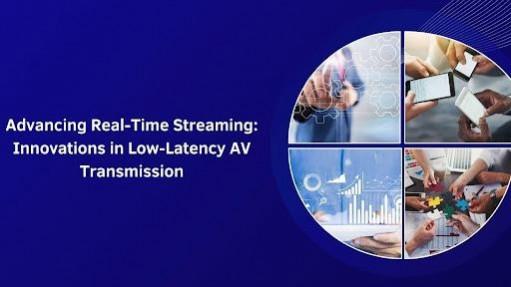
In the modern digital transformation era, multimedia applications demand seamless, real-time streaming solutions that prioritize low latency without compromising quality. Researchers Jyothiprakash Reddy Thukivakam and Sayanna Chandula have explored innovative techniques using the H.264 compression standard and the Real-time Transport Protocol (RTP) to optimize network-based audio-video (AV) transmission. Their research presents a comprehensive strategy to minimize latency while ensuring efficient encoding, packetization, and synchronization.
The Power of H.264 for High-Efficiency Streaming
H.264 (AVC) revolutionizes video compression by minimizing bandwidth while preserving quality. Using intra-frame and inter-frame prediction, it optimizes storage and transmission across resolutions, from QCIF to UHD. Its Network Abstraction Layer (NAL) ensures seamless real-time streaming over the network.
Optimizing Packetization for Low-Latency Delivery
Efficient packetization is crucial for real-time video delivery. The study explores three primary RTP packetization modes: Single NAL, Fragmentation Unit-A (FU-A), and Single-Time Aggregation Packets (STAP). Each mode presents trade-offs between latency, error resilience, and computational overhead.
- Single NAL Mode: Directly transmits entire NAL units in RTP packets, ensuring minimal latency but increasing vulnerability to packet loss.
- FU-A Mode: Splits large NAL units into smaller RTP packets, optimizing transmission over networks with strict packet size limitations. This technique reduces latency by 30–40% compared to traditional methods.
- STAP Mode: Combines multiple NAL units into a single RTP packet, reducing transmission overhead while maintaining synchronization. This approach is particularly effective for sending supplementary metadata like sequence and picture parameter sets.
Encoder Configuration Strategies for Real-Time Applications
Optimizing encoder settings is key to low-latency streaming. Baseline and Constrained Baseline Profiles ensure fast encoding with minimal complexity. Short GOP sizes improve error recovery, while longer ones enhance compression at higher latency. Placing IDR frames every 1–2 seconds aids scene transitions, and avoiding B-frames minimizes delays.
Synchronizing Audio and Video Streams
Synchronizing audio and video in streaming is challenging. RTP ensures alignment using timestamps based on a 90 kHz clock, while adaptive buffering smooths playback. MPEG Transport Stream (TS) uses a 27 MHz system clock and Program Clock Reference (PCR) for precise timing. Integrating synchronization protocols enables seamless lip-syncing with minimal latency, even under fluctuating network conditions.
Transport Protocols: UDP vs. TCP
Selecting the right transport protocol is crucial for streaming performance. User Datagram Protocol (UDP) offers low latency and is ideal for real-time applications but lacks guaranteed packet delivery. In contrast, Transmission Control Protocol (TCP) ensures reliable data transfer through acknowledgments and retransmissions, introducing additional delay.
For optimal low-latency performance, a hybrid approach is recommended using UDP for media transmission while TCP manages session control and signaling. Adaptive streaming techniques and error resilience mechanisms, such as flexible macroblock ordering (FMO) and RTCP feedback loops, help mitigate packet loss without increasing latency. This combination enhances streaming efficiency by balancing reliability and speed, ensuring smooth playback even in fluctuating network conditions.
Implementing Low-Latency Streaming with GStreamer
GStreamer, an open-source multimedia framework, provides a robust implementation of the proposed techniques. The study outlines a real-time streaming pipeline where a sender encodes and transmits video using x264 encoding and RTP packaging, while the receiver decodes and displays the stream with minimal delay. Key optimizations include:
- Configurable bitrate and keyframe intervals to balance quality and latency.
- RTP payload adjustments to match network conditions.
- Adaptive buffering and synchronization techniques for smoother playback.
In conclusion, Jyothiprakash Reddy Thukivakam's research on low-latency AV streaming underscores the effectiveness of H.264 and RTP in optimizing real-time multimedia applications. Through efficient encoding strategies, optimized packetization methods, and adaptive synchronization techniques, the study offers a robust framework for reducing latency while preserving high-quality streaming. As network infrastructure advances, these innovations will be instrumental in shaping the future of real-time content delivery.

















